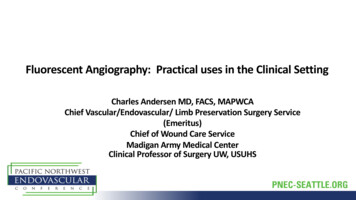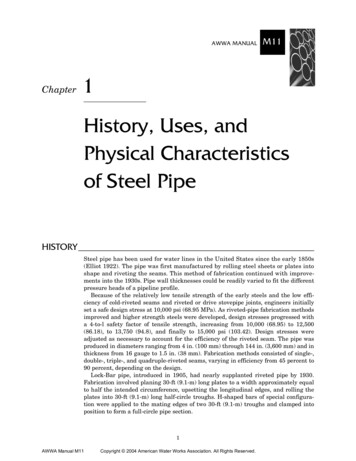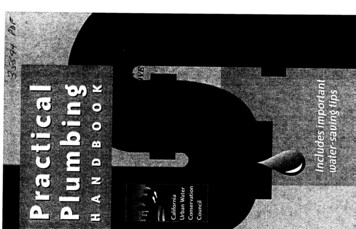
Transcription
Fluorescent Angiography: Practical uses in the Clinical SettingCharles Andersen MD, FACS, MAPWCAChief Vascular/Endovascular/ Limb Preservation Surgery Service(Emeritus)Chief of Wound Care ServiceMadigan Army Medical CenterClinical Professor of Surgery UW, USUHS
Disclosures No relevant financial relationship reported
Perspective Practical Uses in the clinical setting Fluorescent Angiographic Studies provide information that can beuseful in the clinical setting when combined with other clinicalinformation Fluorescent Angiography has become an important tool in ourWound Care and Limb Preservation Service
Traditional measurement of Tissue Perfusion Clinical Judgment Physical exam ABIs, Toe Pressures, Toe Wave Forms Forefoot PVR Duplex scan tcP02 SPP
Measurement of Tissue Perfusion Current methods utilized to evaluate tissue perfusion are often limited by medial calcinosisscarringwoundsprior amputationsinfection Current methods can be technically challenging, costly and time consuming anddon’t measure global perfusion of the foot Fluorescence Angiography offers an additional option to measure tissue perfusion
Clinical Role of Fluorescence Angiography Utilized in outpatient clinic Is there adequate perfusion to heal a wound Does the patient require revascularization to heal a wound or prior to a minorfoot amputation? Was revascularization successful in improving perfusion to the foot? Predict what level of minor foot amputation will heal? Utilized in ORüSpy assisted AmputationüPrevention of suture line complications
Fluorescence AngiographyVisualize and quantitate micro-circulation
Fluorescence AngiographyFluorescent dye ICG) is injected IVThe injected agent lights up blood flowingthrough the veins and arteries in real time,and the camera captures live images of thepatient’s vasculature.These images can be captured on a computerscreen, analyzed and saved and printed formedical reference.
Practical Uses in the Clinical SettingHeel UlcersFluorescent Angiography provides perfusion assessment of the Heelthat can’t be obtained with traditional methods of measuringperfusion
Perfusion Assessment in Heel Ulcers Measurement of tissue perfusion can help assess the healing potentialin patients with heel ulceration Traditional methods of measuring tissue perfusion are a poor indicatorof heel perfusion. Fluorescence angiography can measure tissue perfusion in a heel ulcerMalik R, Pinto P, Bogaisky M, et al. Older adults with heel ulcers in the acute care setting: frequency of noninvasive vascular assessment,surgical intervention, and 1-year mortality. J Am Med Dir Assoc. 2013;14(12):916-919.
Heel Ulcers - Heel AngiosomeThe heel is a unique angiosomedue to it having two sources ofarterial blood supplyClemens MW, Attinger CE. Angiosomes andwound care in the diabetic foot. Foot AnkleClin. 2010;15(Clemens MW, Attinger CE.Angiosomes and wound care in the diabeticfoot. Foot Ankle Clin. 2010;15(3):439posterior tibial arteryperoneal arteryno direct artery toartery connectionsClemens MW, Attinger CE. Angiosomes and wound care in the diabetic foot. Foot Ankle Clin. 2010;15(3):439-464
Heel Ulcers“Orphan Heal Syndrome” Regional malperfusion of the heel has been termed“Orphan Heel Syndrome” Most common in patients with diabetes and/or renal failureThe role of fluorescein angiography in the management of orphan heel syndrome Authors: Nicole Byerley, DPM*, Col (Ret) Charles A.Andersen, MD, FACS, FAPWCA1, Mario N. Ponticello, DPM, FACFAS, FAPWCA2, LTC, MC, Peter Kreishman, MD3 The Journal of DiabeticFoot Complications, 2016
Heel Ulcers – Identification of Ischemia A palpable DP pulse doesn’t r/o heel ischemia Normal ABI or toe pressures do not predict heel ischemia ABI – measure the pressure where the cuff is located. Toe pressures – Anterior tibial perfusion Patients with heel ulcers having arteriography 14% - severe malperfusion about the heel 33% undergoing endovascular interventionTaylor Z. The diagnostic triad of orphan heel syndrome: posterior tibial and peroneal artery occlusive disease, poorlycontrolled diabetes and renal failure. J Vasc Surg 2013;58:565.
Case Study 81 year- old female with a history of poorly-controlled insulindependent DM type II with neuropathy with a painful right posterolateral heel ulceration that had been present for three weeks Physical Exam è non-palpable pedal pulses ABI – 0.5
Presentation
Pre RevascularizationFluorescence Angiogram Pre revascularizationNo fluorescence in wound bed andminimal inflammatory response Heel demonstrates blotchy uptake
Pre RevascularizationFluorescence Angiogram
Revascularization An arteriogram demonstrated popliteal occlusion and severeinfra-popliteal disease Popliteal stent and angioplasty of the tibial peroneal trunk The only runoff vessel was a peroneal artery reconstituting the distaldosalis pedis artery. The posterior tibial artery was totally occluded Indirect revascularization – Is there perfusion to the heel?
Revascularization
Revascularization
Revascularization Post Stenting, arterial flow to the foot was improved with a triphasicdorsalis pedis arterial signal and after several days a monophasicposterior tibial signal. Question – what is the perfusion to the heel Fluorescence angiography demonstrated improved perfusion to theheel with an improved inflammatory response and increased uptaketo the wound bed.
Post Revascularization - Fluorescence Angiogram
One Month Post Revascularizations
Changes in Perfusion6/21/20167/22/20169/01/2016Global Ingress2.47.01.9Wound Ingress8.47.715.1
Healed UlcerUlcer healed 6 weeks post stenting
Practical use Fluorescence Angiography in Heel Ulcers Documented severe ischemia of heel and the need forrevascularization Documented adequate perfusion to the heel following indirectrevascularization With indirect revascularization, documented the increased perfusionover time Appropriate identification of regional ischemia and revascularizationcan prevent major amputation or support calcanectomy in moresevere ulceration
Practical Uses in the Clinical SettingDigital Amputations Significant incidence of readmission and revision to higher levels ofamputation following digital amputations Significant incidence of suture line complications Fluorescence angiography pre and intra op may decrease thesecomplicationsPredictors of hospital readmissions after lower extremity amputations ersen et al publication pending
Case Study - Hallux Amputation 79 y/o diabetic male with multiple comorbidities admitted with Gangrene Osteomyelitis Cellulitis right great toe and dorsal foot 2-3 week history of pain and swelling Poor historian – not sure of trauma History of DVT with chronic venous insufficiency PAD Atrial fibrillation
Case Study - continued Positive blood cultures for MRSA Started on broad spectrum IV antibiotics with resolution of cellulitison dorsum of foot Vascular assessment Fluorescence angiography Right hallux amputation
Pre-op
Pre-op
Pre-op MRI Abscess surrounding the flexor hallucis longus Tendon is concerning for infective tenosynovitis Moderate osteoarthritis of the right foot
Pre op Vascular Assessment ABIs – non compressible vessels with ABIs greater than 1.5 Biphasic wave forms at right ankle Right toe pressure not obtainable
Pre–op Fluorescence Angiography
Intra – op Fluorescence Angiography
AmputationFlap revision following intra-opFluorescence Angiography
AmputationAmputation following excision ofischemic distal flap
AmputationFlap Closure
Fluorescent AngiographyFollowing Closure
Post Op2 days post op5 days post
Practical Uses in the Clinical SettingTMA Historically TMAs have up to a 50% incidence of suture linecomplications Can the use of Fluorescence Angiography decrease the suture linecomplication rate?
Case Study - TMA Severe poorly controlled diabetes S/P hallux amputation with severe deformity with recurrentulceration and cellulitis Vascular studies and fluorescent angiography demonstrated adequateperfusion to heal a TMA Elective TMA
Pre opPost Hallux amputation with deformityof residual toes exposed hardware andchronic osteomyelitis
Fluorescent Angiography Assisted Amputations
Fluorescent Angiography Assisted Amputations
Suture Line Modification
TMA
Ten days post op
Two months post op
Conclusions Fluorescence Angiography has become an important componentof our Limb Preservation/Wound Care practice Fast and accurate evaluation of tissue perfusion of the foot Fluorescence Angiography can assess the need forrevascularization and document the post procedure results Assesses perfusion to determine amputation level Help prevent suture line complications with amputations
References Braun JD, Trinidad-Hernandez M, Perry D, Armstrong DG, Mills JL. Early quantitative evaluation ofindocyanine green angiography in patients with critical limb ischemia. J Vasc Surg 2013;-:1-6. Gurtner GC, Jones GE, Neligan PC, Newman MI, Phillips BT, Sacks JM, Zenn MR. Intraoperative laserangiography using the SPY system: review of the literature and recommendations for use. Ann Surg InnovRes. 2013 Jan 7;7(1):1. Perry D, Bharara M, Armstrong, DG, Mills, J. Intraoperative Fluorescence Vascular Angiography: During TibialBypass. Journal of Diabetes Science and Technology. Volume 6, Issue 1, January 2012. Taylor Z. The diagnostic triad of orphan heel syndrome: posterior tibial and peroneal artery occlusivedisease, poorly controlled diabetes and renal failure. J Vasc Surg 2013;58:565. The role of fluorescein angiography in the management of orphan heel syndrome Authors: Nicole Byerley,DPM*, Col (Ret) Charles A. Andersen, MD, FACS, FAPWCA1, Mario N. Ponticello, DPM, FACFAS, FAPWCA2,LTC, MC, Peter Kreishman, MD3 The Journal of Diabetic Foot Complications, 2016
THANK YOU !Mt. Rainier at SunriseDr. Charles AndersenCande98752@aol.com
Fluorescent Angiography: Practical uses in the Clinical SettingCharles Andersen MD, FACS, MAPWCAChief Vascular/Endovascular/ Limb Preservation Surgery Service(Emeritus)Chief of Wound Care ServiceMadigan Army Medical CenterClinical Professor of Surgery UW, USUHS
The role of fluorescein angiography in the management of orphan heel syndrome Authors: Nicole Byerley, DPM*, Col (Ret) Charl es A. Andersen, MD, FACS, FAPWCA1, Mario N. Ponticello, DPM, FACFAS, FAPWCA2, LTC, MC, Peter Kreish











